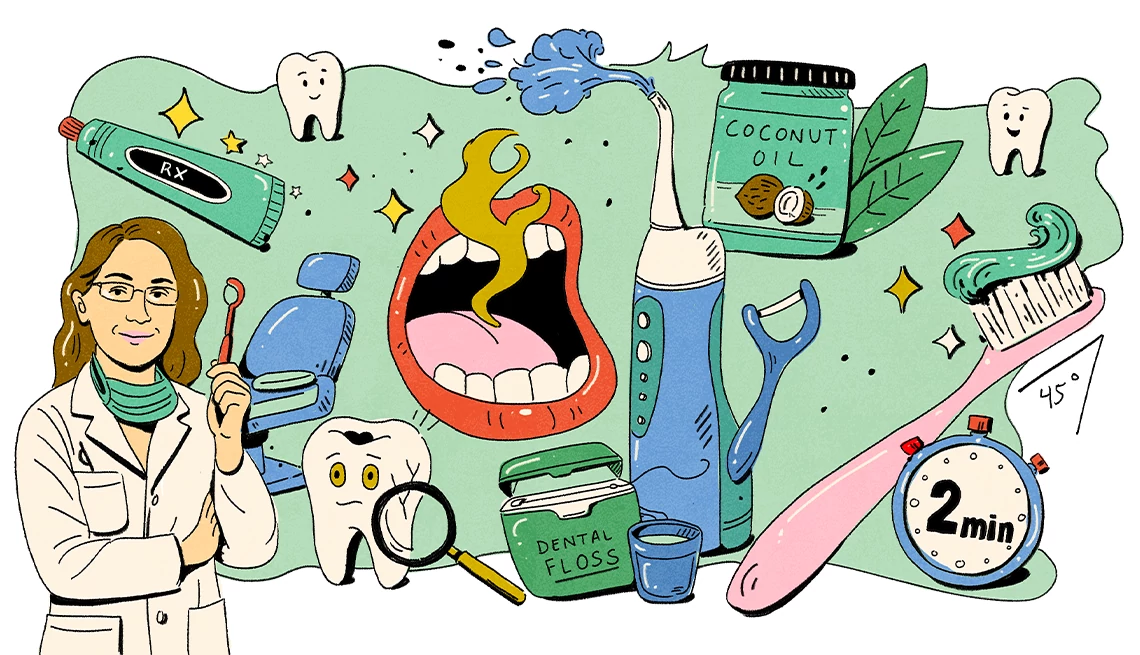AARP Hearing Center


A healthy smile knows no age. At least, not in theory. In practice, however, aging comes with an increased likelihood of cavities, gum disease, tooth loss and oral cancer, according to the U.S. Centers for Disease Control and Prevention (CDC), which attributes older adults’ oral risks to reduced saliva production, receding gums, and difficulties flossing and brushing due to poor vision, cognitive decline, chronic disease and physical limitations. In fact, one in every five adults age 65 or older has untreated tooth decay; nearly as many have lost all their permanent teeth due to oral health challenges; and approximately two in three have gum disease, the American Dental Association (ADA) reports.
The good news: Proper oral hygiene can help people of any age attain and maintain a healthy mouth, says general dentist Heidi Aaronson, owner of New Generation Dental Center in Wellesley, Massachusetts. A fellow of the American College of Dentists, one of Boston magazine’s top dentists in Boston for seven years running, and founder of “Tooth Day at Fenway Park” — an annual event that brings oral cancer awareness to fans of the Boston Red Sox, whose players are among her patients — Aaronson recently shared with us her best tips for fending off cavities, tooth loss, gum disease and other age-sensitive oral maladies.
Brush at a 45-degree angle
You already know you should be brushing your teeth at least twice a day, for two minutes each time. But the angle at which you hold your toothbrush also matters. Don’t hold it straight on — you want to hold the bristles at a 45-degree angle so they get under the gumline. Use thorough, gentle back-and-forth motions. If you’re too aggressive, you’ll harm your gums. The protective enamel that’s on your teeth ends right above where the gums stop. So if you’re brushing your gums away, you’re exposing the root surface, which is much more prone to tooth decay since there’s no protective hard shell there.
Pay special attention to spots that are commonly missed
Often I find that’s the inside of the lower teeth, right by the tongue. There are salivary glands right under your tongue, and they’re constantly squirting saliva onto the back of your lower front teeth. The minerals in that saliva can interact with the plaque on your teeth to form tartar. So that’s where everything tends to build up.
Work to prevent gum disease
Periodontal disease, or gum disease, is caused by bacteria around the teeth and under the gums. And as periodontal disease worsens, you get bone loss, which can lead to tooth loss. Bacteria under the gums can also cause clots to form in blood vessels, which can break off and lead to a stroke. And studies have found links between the bacteria in our gums and Alzheimer’s disease, vascular dementia, heart disease, diabetes and even erectile dysfunction. Flossing is one of the best things you can do to reduce your risk of gum disease. Brushing is not enough.
Find the floss that works for you
The problem for a lot of older adults is that they have dexterity issues, which makes flossing more difficult. There are pre-threaded flossers with handles that make it a lot easier for some people to floss, but I’m not a big fan of those because they cost a lot and you have to buy refills. A good alternative is floss picks. Or there are interproximal brushes that look like little pipe cleaners. I’m a huge fan of those.
Hate flossing? Try a water flosser
Water flossers have been a huge game-changer for a lot of my patients. It’s not exactly the same thing as flossing — a water flosser gets under the gums really, really well, but it doesn’t get in between the teeth — but it’s a very good alternative for people who can’t or won’t floss. Hold it at 90 degrees at the gum level and trace the scalloping of each tooth. You should spend about 30 seconds on each quadrant of your mouth. I’ve seen people with periodontal disease who start using a water flosser, and within six months their periodontal disease is almost resolved. You can buy one for around $30 — and make sure to clean it regularly.
Address dry mouth
Saliva re-mineralizes your enamel to help resist cavities. And it inhibits the growth of harmful bacteria that cause bad breath and tooth decay. But one of the biggest problems for older adults is dry mouth. There are more than 1,000 medications that cause it, including antidepressants, blood pressure and pain medications, tranquilizers and antihistamines. Changes in your body due to menopause and diabetes can also cause dry mouth. So treating it is really important.


































































You Might Also Like
12 Insider Secrets from a Chief Fire Officer
How to keep your family safe from potential home disasters
Top Colorectal Surgeon Shares Insider Secrets for Optimal Health
Why you should skip the flushable wipes and colonics, according to a colorectal surgeon
Insider Secrets From an Airline Pilot
With more people on the move, flying presents increased obstacles. We turned to a veteran pilot for answers